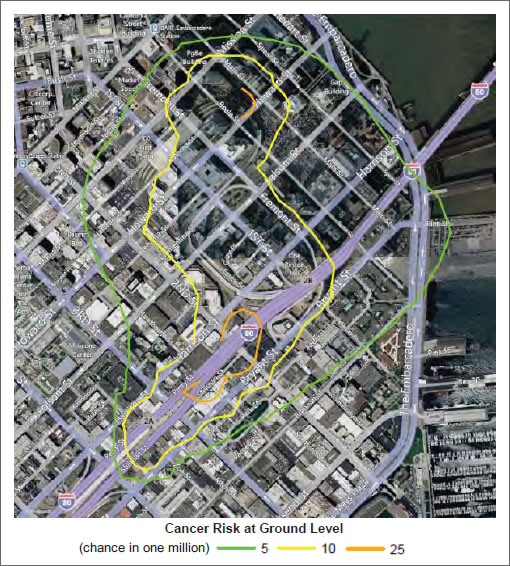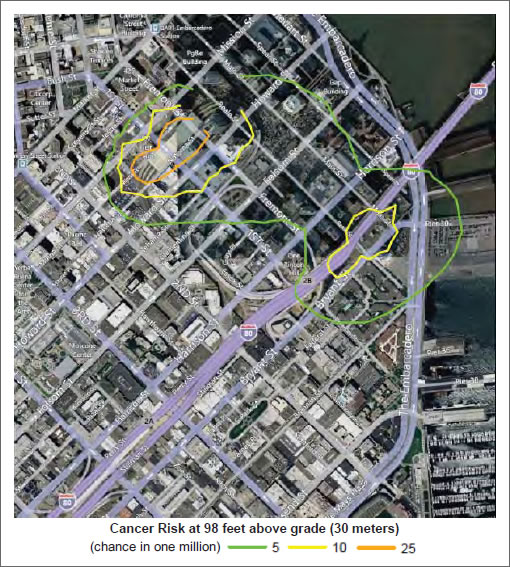
Speaking of the Plan for building out San Francisco’s Transit Center District, from the Plan’s Environmental Impact Report (EIR) with respect to the Transit Center’s estimated impact on air quality and resultant neighborhood cancer risk:
Regarding operation of the Transit Center, because bus operations can be estimated, air quality modeling of diesel buses that will serve the Transit Center was undertaken. The analysis focused on the new Transit Center, because that is where there will be the greatest concentration of diesel-powered buses in the Plan area. The analysis revealed that those bus operations could generate a lifetime cancer risk in excess of 10 in one million at locations proximate to the Transit Center and the ramp linking the terminal to the Bay Bridge, and at elevations from at grade to approximately 100 feet (30 meters) above street level.

Subsequent residential development projects (and other projects with sensitive receptors) in these areas, therefore, would be subject to a potential significant impact from diesel bus emissions, exceeding the 10 in one million BAAQMD project‐specific guideline for a single source impact on new receptors. Therefore, these projects would likely have to implement mitigation measures, such as [installation of a filtration system].
These potential significant air-quality impacts due to exposure to roadway pollutants and stationary source risks, including PM2.5 concentrations and cancer and non‐cancer health risks, would be reduced with implementation of…an overlay zone in which site specific analysis or refined modeling would be required in advance of the approval of subsequent development projects that would include sensitive receptors, and that the Transit Center District Plan include “goals, policies, and objectives to minimize potential impacts.”
Mitigation [Measures] would also require that residential development projects in the Plan area be designed to reduce air quality impacts to residents through building design (e.g., ventilation and air filtration systems). This measure would apply to the entire Plan area because of the large number of permitted and unpermitted stationary sources—mostly diesel generators and boilers—and the high percentage of streets with traffic volumes that could generate relatively high concentrations of PM2.5 throughout the Plan area and vicinity.
Because the pollutant concentrations vary by location, it is not possible to conclude that Mitigation Measures would bring concentrations or the resulting health risks below the BAAQMD‐specified levels for each subsequent project with sensitive receptors. Therefore, this impact would remain significant at the Plan level after mitigation.
Or as has previously been discussed, Freeway Pollution: Conjecture Or Consideration?
∙ The Plan For San Francisco’s Tallest Tower And Transit Center District [SocketSite]
∙ Transit Center District Environmental Impacts and Mitigation Measures [sfplanning.org]
∙ Freeway Pollution: Conjecture Or Consideration? [SocketSite]
Huh. This can’t be good for the property value of The Infinity and Millenium buildings or any of the nearby residential buildings. Will be interesting to see . . .
Seriously..?
We live in one of the most dense urban areas in the country… How is anyone even considering this to be a new concern/focus?
I give up being excited by the nonsense bureaucracy of our urgently progressive community.
Think about the birds!
and this is different from what the prior terminal generated, how? Or is the idea that now that we got rid of that one, we can also derail building a new one?
A 10 in a million chance of cancer if you live there your whole life! Will there still be diesel busses in 20, 40, 50 years anyway? Here’s a simple solution: Move! then your lifetime cancer risk is 400,000 in a million. (National Cancer Institute 2005-2007 data, lifetime risk. http://seer.cancer.gov/statfacts/html/all.html )
lolcat_94123 I agree! Who cares about the people in the infinity. I think the City should fund a study about the impact on birds who fly into the Infinity and survive and then also have higher cancer risk. After all they funded a year long study to look into whether or not selling goldfish in SF could be inhumane and after that year decided that it, ummm, could be inhumane.
this probably means this area will become equivalent to just about any section of NYC – and still far less than most NYC areas with high traffic like times square. snooze
I think I have higher odds of being killed by one of the busses directly. Especially if the bus companies employ former Muni drivers.
What is the baseline risk? My guess is SF Transit Center’s air is way better than many metropolitan is the world. The traffic is relative low. Vehicle emission control standard is some of the tightest. Geography is open and windy. People living in Asian cities choking in smog will be so pleased with the clean air here.
Basically every other major city has at least one, if not multiple transit centers the size of SF’s planned site. I know of no data suggeting increased observed rates of cancer.
This is yet another example of California/Bay Area regulation gone amok.
I wouldn’t be concerned. Ten in one million? In other words, .001%
Yeah, according to some web page I pulled, the lifetime risk of breast cancer for women is 12.2 %
http://www.cancer.gov/cancertopics/factsheet/detection/probability-breast-cancer
So it is 122,000 background breast cancer case v.s. 10 case from transit center’s diesel.
Imagine activists’ outcry upon reading the headline of this report. The context is completely missing.
There is a strong long term trend toward eliminating particulates, so this is a problem that might be solved in our lifetimes. They have to be detailed about this for the Environmental Impact Report, but it isn’t necessarily a problem with the transit center as planned because alternatives, especially improvised alternatives put in place because the plan was somehow scuttled, might pollute even more in the short term.
The jokes about birds are ridiculous. People are complaining about hardships they imagine in order to protect natural assets that are confirmed valuable and easily saved. What is the advantage in creating an alternative reality where bird strikes become a major issue with huge costs already sunk and great impacts to all future projects.
Even more reason to build taller. And plant lots and lots of trees.